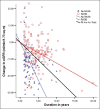Retarding the progression of chronic kidney disease with renin angiotensin system blockade
- PMID: 22787312
- PMCID: PMC3391807
- DOI: 10.4103/0971-4065.97126
Retarding the progression of chronic kidney disease with renin angiotensin system blockade
Abstract
We assessed the effect of renin angiotensin system blockade (RASB) in chronic kidney disease (CKD) of diverse etiology. Two hundred and sixty-five consecutive CKD patients attending our renal clinic, with estimated glomerular filtration rate (eGFR) of 20-70 ml/min/1.73m(2) at baseline and a minimal follow-up of 1 year, were studied retrospectively. We devised a scoring system to quantify RASB, wherein the maximum dose of an agent recommended for control of hypertension was scored as 1. The renal endpoints studied were the rate of change in eGFR (ΔeGFR) and decline of eGFR>50%. The mean age was 48 ± 11.2 years and 69% were male. The mean duration of follow-up was 4 ± 2.7 years. The rate of ΔeGFR was -1.5 ± 5.0 ml/min/1.73 m(2) per year in patients who received RASB (N=168) and -6.0 ± 5.4 in those who did not (N=97) (P<0.001). The incidence of decline of eGFR >50% was 11.3% with RASB and 24.7% without (P=0.003). In a subgroup of patients who received RASB, the incidence of decline of eGFR >50% was 17.8% in the low-dose RASB group (N=84, RASB score 0.63 ± 0.38) and 4.8% in the high-dose group (N=84, RASB score 2.5 ± 0.7) (P=0.001). RASB was associated with significantly better renoprotection in CKD of diverse etiology, even in nonproteinuric diseases. This effect appeared to be dose-dependent, with higher supramaximal doses exhibiting better renoprotection than the lower conventional doses. Our results make a strong case for use of aggressive RASB in all CKD patients to postpone end-stage renal disease.
Keywords: Chronic kidney disease; progression of nephropathy; renin angiotensin system blockade.
Conflict of interest statement
Figures



References
-
- Kher V. End-stage renal disease in developing countries. Kidney Int. 2002;62:350–62. - PubMed
-
- Modi GK, Jha V. The incidence of end-stage renal disease in India: A population-based study. Kidney Int. 2006;70:2131–3. - PubMed
-
- Mani MK. Treating renal disease in India's poor - the art of the possible. Semin Nephrol. 2010;30:74–80. - PubMed
-
- Mani MK. Nephrologists sans frontiers: Preventing chronic kidney disease on a shoestring. Kidney Int. 2006;70:821–3. - PubMed
-
- Mani MK. Experience with a programme for prevention of chronic renal failure in India. Kidney Int Suppl. 2005;94:S75–8. - PubMed
LinkOut - more resources
Full Text Sources
Research Materials
Miscellaneous

